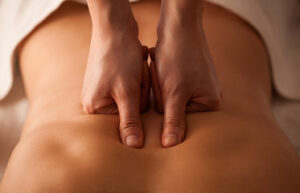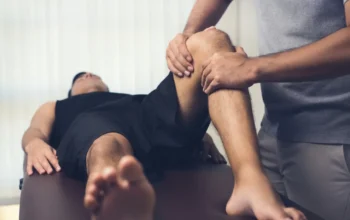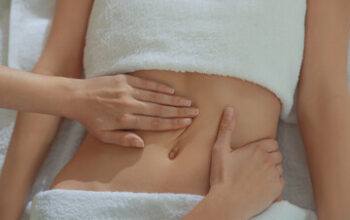Massage involves rubbing or kneading the body’s soft tissues. It is used to relieve pain, reduce stress, and increase blood and lymph circulation.
One study suggests that massage decreases cortisol and increases serotonin, neurotransmitters that stabilize mood. Massage may also reduce anxiety and insomnia in people with chronic illnesses such as menopause or congestive heart failure. Visit their Website to learn more.
Massages vary in style and intensity, but most produce the same basic physiological effects: they calm the nervous system by decreasing your heart rate and blood pressure, reducing muscle tension and stiffness, and boosting circulation. The therapist’s touch also stimulates the skin and encourages lymphatic drainage, helping eliminate waste products and other debris that accumulate in tissues.
Many forms of massage involve stroking, kneading or pushing on pressure points in the body called trigger points. These are painful areas of tight muscles that can be released by applying deep pressure to these spots, which helps ease and relieve pain throughout the body. Massage can help with back, neck and shoulder pain; headaches; and even depression.
A massage may help prevent and treat sports injuries and chronic conditions such as arthritis and fibromyalgia. It can also speed recovery from surgery and alleviate stress after an injury. Research shows that a regular massage decreases the levels of stress hormone cortisol, and increases serotonin and dopamine. These brain chemicals are responsible for regulating your mood.
The increased blood flow that occurs with massage helps drain away the toxins stored in cells and tissues, which improves your energy level and can help you sleep better at night. It can also help you avoid pressure sores by allowing your body to circulate more fluids.
If you have a condition such as diabetes or high blood pressure, talk to your doctor before getting a massage. Certain types of massage can increase your blood sugar levels or cause an imbalance in your electrolytes (minerals that regulate your body’s water balance). If you are pregnant, have a bleeding disorder, or have a pacemaker or internal defibrillator, do not receive a deep tissue or trigger point massage. The deep pressure and intense heat may cause damage to the tissues. Also, if you have a condition such as edema, which is the accumulation of excess fluid in tissues, speak to your doctor before having a massage. It is important to be able to discuss all the risks and benefits of massage therapy before your appointment.
Techniques
Massage involves pressing, rubbing and manipulating the skin, muscles, tendons and ligaments. Its benefits can range from relaxation to pain relief. It is often used in conjunction with standard treatment for many medical conditions and situations. Massage may be provided in a number of settings, including hospitals and private practice.
Almost all cultures have developed systems of therapeutic massage. Early Swedish massage was systematized in the 19th century by Per Henrik Ling, who believed that vigorous massage could promote healing by improving circulation. Modern therapists use a wide variety of techniques, from light stroking (effleurage) to deep friction and tapping. They also take into account the recipient’s comfort level and goals for the session.
One of the most important elements of massage is communication. The therapist should ask questions about the person’s health history and any specific areas of tension. The therapist should also be able to communicate effectively with the person receiving the massage to ensure that the pressure is not too much or too little.
Reflexology is a specialized form of massage that focuses on the feet, hands and ears. It is based on the theory that there are “zones” in the feet, hands and ears that have direct nervous connections to other parts of the body — and even organs. Using pressure applied to these reflex points is said to stimulate the body’s natural healing processes.
Another type of massage is called Rolfing, which uses gentle but firm massage to lengthen and reposition connective tissue, or fascia, to improve posture and alignment. It is sometimes used in combination with other modalities, such as deep-tissue massage and stretching, to help people overcome injuries or improve sports performance.
Therapeutic massage is often performed in hospital settings, such as maternity units and in care for children with profound disabilities. It is also sometimes offered in conventional care settings by nurses or unpaid community practitioners. Studies have shown that massage can relieve anxiety and enhance mood in psychiatric patients, and reduce the frequency of seizures in those with epilepsy. It can also increase the weight gain of premature and low birth-weight infants, and decrease the length of stay in hospital for chronically ill people.
Preparation
The therapist will need access to the area you are having massaged so that they can work over the muscles. This means you will need to undress down to your underwear or shorts. If you are uncomfortable with this you can always ask the therapist to work over a sheet instead. It is a good idea to take a shower before your massage so that you can start with clean skin. This will also ensure that any sweat or dirt doesn’t get mixed into the warm oils that are being used during your massage. Showering is not only hygienic but it can also help you to relax before your massage.
The best time to have a massage is on your rest days. This will not only help you to recover from your sporting efforts but it can also help with the preparation for your next event. It is not recommended that you schedule a massage on the day of your next event as this can be too taxing on your body.
If you have to have a massage on your active days try to schedule it in the morning or in the afternoon rather than at night. This will allow you to sleep well and also helps reduce the chance of experiencing sore or aching muscles in the days that follow your treatment. This is called Delayed Onset Muscle Soreness or DOMS for short and is quite normal.
A massage is an excellent way to relieve stress and it can help improve your circulation so that your muscles get the blood they need to function properly. You may however experience some muscle soreness in the days after your treatment, especially if you had deep tissue massage or an intense sports massage but this is not something that should last more than a few days.
It is a good idea to drink lots of water in the days leading up to your massage appointment. This will help your kidneys to flush out the toxins that are released during the massage and which can lead to inflammation. If you have a large meal before your massage it is not recommended as the gentle movement of the massage could cause indigestion or discomfort.
Posture
Good posture is more than just standing up straight so you look better; it can also reduce back pain, help you breathe easier and even improve mood. But keeping a good posture isn’t always easy and many people with MS struggle to do so because of muscle weakness, pain or fatigue. This can also make other MS symptoms worse or harder to deal with.
Posture is the way you hold your body when you’re sitting, standing or lying down. It could be hunching over a computer, walking with your head down or slouching in a chair. Poor posture isn’t necessarily a choice and can develop gradually over years of poor habits. But good posture can help keep your bones in the right place so they don’t get twisted or damaged, and it will also mean that your muscles work less and need to be relaxed less often.
There are two types of posture: dynamic and static. Dynamic posture is the way you hold your body when you’re moving, like when you’re walking or running. Static posture is the way you hold your body when it’s not moving, such as when you’re sitting or sleeping.
A ‘good’ posture is one where the joints are aligned with the limbs and the spine. It’s a position where the weight is evenly distributed and your muscles are working in balance. You can’t achieve a perfect posture because everyone’s body is different but there are some things you can do to help:
Good posture involves having the right balance of dynamic and static posture. Having dynamic posture is important because it keeps the support muscles in your back and stomach active, which prevents them from getting too weak and shortening too much. Having static posture is important because it stops the deeper support muscles from burning up all of your energy and making you tired quickly.
Massage can help by increasing the flexibility of your muscles and reducing stiffness in your joints. It can also break down adhesions in your muscles (the tight knots that form when muscles are overused), which can help your muscles work more effectively and maintain a healthy, flexible posture.


